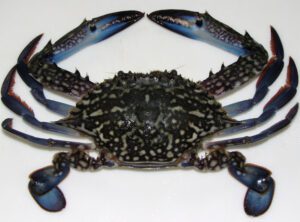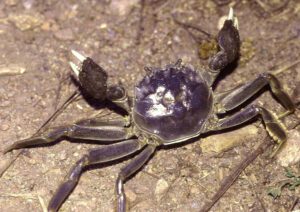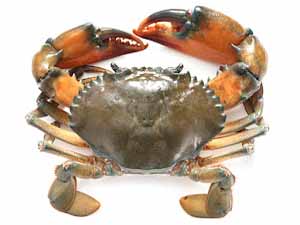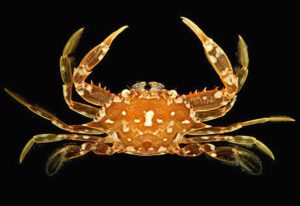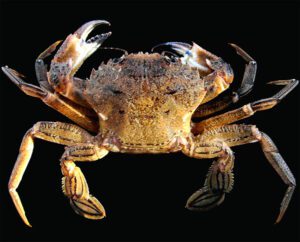The Snow crab is a predominantly epifaunal crustacean which is native to shelf depths in the northwest Atlantic Ocean and north Pacific Ocean.
It is also called Queen crab, Tanner crab and Chionoecetes opilio. It is well-known commercial species of Chionoecetes.
There are seven species in the genus Chionoecetes, and all of which bear the same name ‘Snow crab‘.
It is also related to Chionoecetes tanneri, which is commonly known as the Tanner crab. And other species are generally found in the cold, northern Oceans.
The Snow crabs are found in the Western Atlantic from Greenland, Newfoundland to the Gulf of Maine.
In the North Pacific they are found from Arctic Alaska westward to northern Siberia and southward through the Bering Strait to the Aleutian Islands, Okhotsk, Kamchatka, Korea and Japan.
The Snow crab is economically a very important species of crab and it is often caught with traps or by trawling.
The male crabs with a total length of above 9.1 cm long are the most commonly trapped. However, read some more information about this crab species below.
Snow Crab Characteristics
The Snow crabs have almost equally wide and long carapaces, or protective shell-coverings over their bodies.
Their tubercles, or the bodily projections on their shell, are moderately enclosed in calcium deposits, and they boast hooked setae, which are rigid, yet springy, hair-like organs on their claws.
These crabs generally have a horizontal rostrum at the front of the carapace.
Their rostrum is actually just an extension of the hard, shell covering of the carapace and it boasts two flat horns separated by a gap. They have well-defined gastric and branchial regions internally, and have triangular spines.
The Snow crabs also have little granules along the border of their bodies, except their intestinal region. Their first 3 walking legs are compressed. Their chelipeds or pincers are generally smaller, shorter or equal to their walking legs.
In case of coloration, the Snow crabs are iridescent and range in color from brown to light red on top and from yellow to white on the bottom, and are bright white on the sides of their feet.

The mature male Snow crabs can reach up to 15 cm. But the females are much smaller than the males. On an average, the females can grow around 9 cm. Carapace of the male crabs are generally around 7 cm in length and width, and around 5.5 cm for the females. Photo and info from FAO and Wikipedia.
Diet
The Snow crabs are scavengers. They eat other invertebrates that reside in the benthic shelf such as bivalves, brittle stars, polychaetes, crustaceans and even phytobenthos and foraminiferans.
Aside from preying on other benthic shelf invertebrates, they also prey on annelid worms and mollusks. Generally the females are poor predators than the males.
The mature crabs are mainly feed on annelids, crustacean decapods and fish. Cannibalism is also practised at times among snow crabs, most frequently by intermediate-sized females.
Breeding
The Snow crabs have a very high reproductive potential. Each single female crab carries eggs each year.
A female crab can carry up to 150,000 eggs under their abdomens after mating. And the females are fertilized internally.
The male crabs are capable of mating at both immature and mature stages of their lives. The females generally lay their eggs in very deep areas of the ocean such as in deposits of phytodetritus.
Uses
The Snow crabs are edible crabs. They are mainly used for food.
Special Notes
The Snow crab is an economically important crab species. It was commonly caught by trappers in the 1980s, although trapping has decreased since then. And much of the trapping has been in Canada for commercial use. In the year of 2013, the first commercial fishing for the species in the Barents Sea
The mature Snow crabs generally live between 5 and 6 years. They generally molt and mate a final time before their deaths, and then die. These crabs usually grow slowly and are structured according to their size. There are at least 11 recognized stages for male crabs.
Currently the Snow crabs are very abundant in the Atlantic Ocean region. More specifically they are found in the Western Atlantic area near Greenland, Newfoundland, in the Gulf of St. Lawrence and on the Scotian Shelf.
The Snow crabs prefer to live in the benthic shelf and upper slope of the ocean. They love to live in the sandy and muddy bottoms, and in depths as shallow as 20 meters and as deep as 1,200 meters. Most often they can be found at 70-280 meter depths in the Atlantic waters.
The Snow crabs are mainly used for food. They are very popular as food in some countries. Steamed Snow crab is very popular. However, review full breed profile of the Snow crab in the following table.
| Name | Snow Crab |
| Kingdom | Animalia |
| Phylum | Arthropoda |
| Class | Malacostraca |
| Order | Decapoda |
| Family | Oregoniidae |
| Genus | Chionoecetes |
| Species | C. opilio |
| Binomial Name | Chionoecetes opilio |
| Other Names | Also known Queen crab, Tanner crab and Chionoecetes opilio |
| Breed Purpose | Food |
| Special Notes | Economically important crab species, 5-6 years average lifespan, generally molt and mate a final time before their deaths, and then die, grow relatively slowly, currently very abundant in the Atlantic ocean region, these crabs generally prefer to live in the benthic shelf and upper slope of the ocean, love to live in the sandy and muddy bottoms, mainly used for food, very popular as food in many countries |
| Breeding Method | Natural |
| Climate Tolerance | Native climate |
| Body Color | Iridescent and range in color from brown to light red on top and from yellow to white on the bottom, and are bright white on the sides of their feet |
| Rarity | Common |
| Availability | Northwest Atlantic and north Pacific Oceans |
